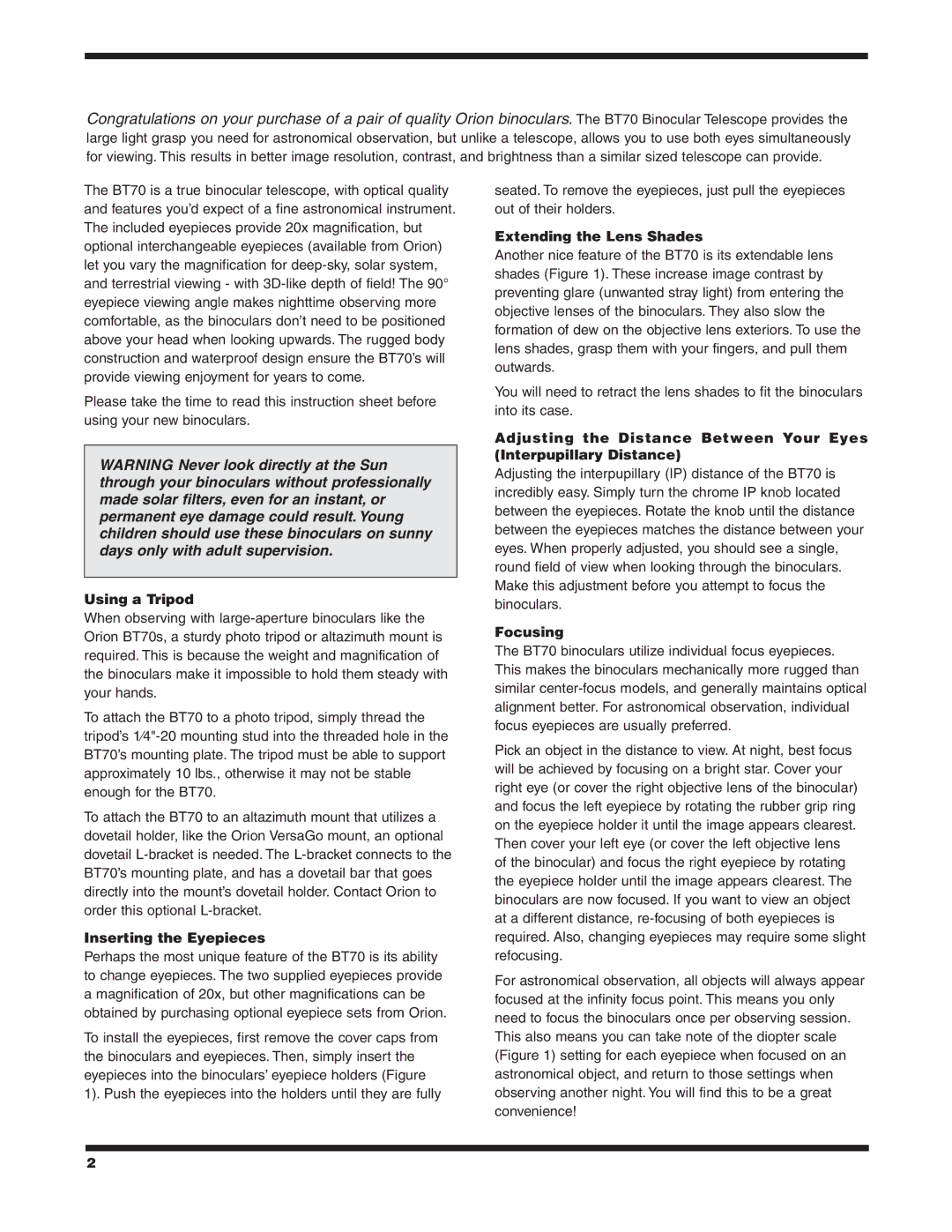
Congratulations on your purchase of a pair of quality Orion binoculars. The BT70 Binocular Telescope provides the large light grasp you need for astronomical observation, but unlike a telescope, allows you to use both eyes simultaneously for viewing. This results in better image resolution, contrast, and brightness than a similar sized telescope can provide.
The BT70 is a true binocular telescope, with optical quality and features you’d expect of a fine astronomical instrument. The included eyepieces provide 20x magnification, but optional interchangeable eyepieces (available from Orion) let you vary the magnification for
Please take the time to read this instruction sheet before using your new binoculars.
WARNING Never look directly at the Sun through your binoculars without professionally made solar filters, even for an instant, or permanent eye damage could result. Young children should use these binoculars on sunny days only with adult supervision.
Using a Tripod
When observing with
To attach the BT70 to a photo tripod, simply thread the tripod’s
To attach the BT70 to an altazimuth mount that utilizes a dovetail holder, like the Orion VersaGo mount, an optional dovetail
Inserting the Eyepieces
Perhaps the most unique feature of the BT70 is its ability to change eyepieces. The two supplied eyepieces provide a magnification of 20x, but other magnifications can be obtained by purchasing optional eyepiece sets from Orion.
To install the eyepieces, first remove the cover caps from the binoculars and eyepieces. Then, simply insert the eyepieces into the binoculars’ eyepiece holders (Figure
1). Push the eyepieces into the holders until they are fully
seated. To remove the eyepieces, just pull the eyepieces out of their holders.
Extending the Lens Shades
Another nice feature of the BT70 is its extendable lens shades (Figure 1). These increase image contrast by preventing glare (unwanted stray light) from entering the objective lenses of the binoculars. They also slow the formation of dew on the objective lens exteriors. To use the lens shades, grasp them with your fingers, and pull them outwards.
You will need to retract the lens shades to fit the binoculars into its case.
Adjusting the Distance Between Your Eyes (Interpupillary Distance)
Adjusting the interpupillary (IP) distance of the BT70 is incredibly easy. Simply turn the chrome IP knob located between the eyepieces. Rotate the knob until the distance between the eyepieces matches the distance between your eyes. When properly adjusted, you should see a single, round field of view when looking through the binoculars. Make this adjustment before you attempt to focus the binoculars.
Focusing
The BT70 binoculars utilize individual focus eyepieces. This makes the binoculars mechanically more rugged than similar
Pick an object in the distance to view. At night, best focus will be achieved by focusing on a bright star. Cover your right eye (or cover the right objective lens of the binocular) and focus the left eyepiece by rotating the rubber grip ring on the eyepiece holder it until the image appears clearest. Then cover your left eye (or cover the left objective lens of the binocular) and focus the right eyepiece by rotating the eyepiece holder until the image appears clearest. The binoculars are now focused. If you want to view an object at a different distance,
For astronomical observation, all objects will always appear focused at the infinity focus point. This means you only need to focus the binoculars once per observing session. This also means you can take note of the diopter scale (Figure 1) setting for each eyepiece when focused on an astronomical object, and return to those settings when observing another night. You will find this to be a great convenience!
2
